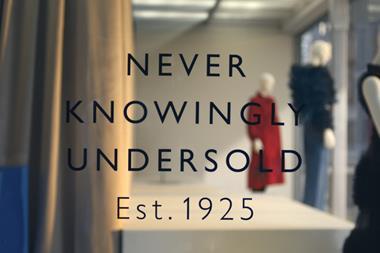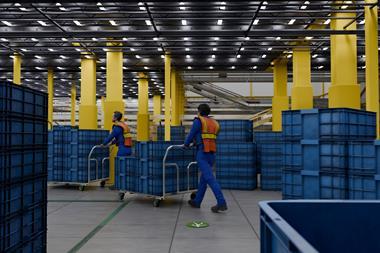In just a few years consumer power has encouraged retailers to set up multiple selling platforms and offer cross-channel services. Joanna Perry examines how far multichannel has come
Retail no longer equals stores. Of course, there has always been mail order but the proliferation of the web has not only created an e-commerce channel but reignited consumers’ and retailers’ interest in other ways of shopping.
Hip and up and coming retailers are talking about catalogues, and retailers are facilitating the selling of their customers’ second hand goods through dedicated websites. Even channels such as TV shopping could be looked at again, as internet providers such as BT try to leverage the investments they are making in internet-based TV services.
Speaking at the National Retail Federation convention in New York, Tesco.com chief executive Laura Wade-Geary said that her time running Tesco’s online business has been the most rewarding and challenging of her career so far.
However, she pointed out that the days of retailers doing multichannel goes back further than you might think – as far back as the butcher’s bike in her eyes.
This proliferation of choice is changing the way that customers shop. For several years now the industry has been obsessed with the statistics that show how many consumers view websites before they go to stores. The reality is almost certainly more complex.
Mydeco chief executive David Kelly says that the assumptions about how consumers shop, simply researching online and then buying from store, or viewing a product in the store and then going home and buying online, are too simplistic. In fact, the processes that customers go through are much less linear and may involve several channels, sometimes more than once, before a purchase is made. Kelly says: “People are starting to get influences from lots of places. The consumer really is clued up.”
Mydeco has launched tools such a 3D room planner and, more recently, a mood board to appeal to female shoppers. Kelly says: “We need to give our customers tools that reflect how they think about purchases.”
Market research company eDigital’s research director Chris Russell agrees that retailers should be following their customers’ lead. “I would counter any retailer who says that they are multichannel, because consumers are cross channel. Consumers don’t regard it as a multichannel experience,” he says.
Russell says 2004 was a tipping point in terms of consumer behaviour and this has happened again in the past six months, with rising costs leading customers to choose more cost effective channels, and deep discounting taking place.
The emergence of new shopping channels in the past decade has fundamentally changed the strategies of some retailers.
Take Hawkin’s Bazaar, for instance. It trades on the web, via mail order and through a growing chain of stores. In addition, its parent company Tobar also runs a wholesale business.
Across its business-to-consumer channels the decision has been taken that the company must appear joined up to customers.
Hawkin’s Bazaar direct marketing manager Sophie Williams says that the company takes the stance that services and propositions must work across its various channels or the company will not offer them.
The site allows shoppers to find their nearest store and also find which stores have product in stock. Williams says it is easy to do, but lots of retailers don’t because they are worried about getting their stock thresholds wrong, and saying something is in stock when it is not. Hawkin’s Bazaar simply gives customers a high, low or out of stock indication rather than specific stock levels.
Tobar has been able to roll out one main system from Maginus for its entire business, which has helped enable it to think in a joined up way. For instance, its stock for all channels is held in one warehouse and can be allocated piece by piece, rather than being reserved for specific channels.
Services it would like to introduce include store delivery for online orders. Williams adds that the retailer would probably only consider introducing kiosks if it offered a deliver to store option, as then the customer would get a complete service.
She says that the company also does not offer gift vouchers at present, as for the moment it is unable to provide vouchers that would work across itsdifferent channels.
One thing Hawkin’s Bazaar has introduced is a card for customers offering free delivery if the product they want is not in stock in a store. Williams says that this has done well, and helps track the behaviour of customers who are shopping across channels. A third who redeem the offer are already on the retailer’s database.
This gives it some visibility of customers who come into stores because they have seen a product in a catalogue that the store does not stock. She explains: “The catalogue is hugely important and would be even if people didn’t buy using it. Our stores use the catalogue as well and it is still profitable.”
Lessons learned
Wade-Geary believes that retailers can learn from the mistakes that retail banks made when they moved to multichannel models. She says: “The banks tried to force customers to avoid high cost processes – rather than re-engineering the processes to lower the cost.”
Tesco.com believes in changing its business to meet its customers’ needs. Wade-Geary adds that most of the innovation and all of the reasons for profitability in the business have been down to attention to detail and innovation that improves things for customers while reducing costs. For instance, Tesco introduced “naked delivery” – without the carrier bags – because it was something that customers said they wanted and Tesco’s order pickers said using bags slowed them down.The company has saved 80 million plastic bags as a result.
Russell says his company is still seeing strong demand for its services. Not only are retailers not turning their backs on online research, they are using it to find out what their customers are doing offline too. He points out that quantitative data will tell you what your customers do, and qualitative data can tell you what customers can’t do, but would like to.
Mydeco intends to take this much further. Kelly promises a new tool will launch early this year that will use location mapping technology to show customers where products they are interested in are available in near-by stores.
The company is also in negotiation with one retailer to roll out Mydeco’s 3D room planner to its stores.
Kelly says that it is the company’s role to keep innovating in this way, especially at a time when retailers may not be able to bear the costs themselves.
At multichannel nursery retailer Kiddicare, there is certainly a willingness to keep innovating and extending the brand. The company’s web sales have soared by 50 per cent year on year since the middle of 2008 and partner Scott Weavers-Wright wants to be able to tap this demand further.
He has lots of ideas about how the company can expand its channels to market. For example, he is considering a tie-up with travel companies this year to offer consumers travel products for next-day delivery.
Kiddicare is also toying with the idea of a multichannel catalogue, which could be introduced this year. Weavers-Wright says that this could be funded from some of the budget that is currently spent advertising on Google.
He is also interested in the idea of trying to tap into the second-hand market. He says that the issues of creating such a channel are more technical than business ones. An auction site could be used to get rid of end of lines too.
The other plan he is still keen to move forward with is for a social networking site, focused on products, reviews and customer focus.
However, Kiddicare’s experience is that although customers are more sophisticated, many still value being able to speak to someone on the phone. As with catalogues, many forecast that the emergence of the internet would do away with a need for phone-based channels, but this does not seem to be holding true.
Weavers-Wright says: “We expect to increase our call centre after our experience in the last quarter. There is no doubt that the customer feels a bit cautious and wants validation. There is no doubt that customers are calling us more.”
The next phase of multichannel expansion will also show how far different sectors within retail are prepared to adopt the same channels and services. Russell points out: “There is no doubt that click and collect services have changed electricals, but we are not seeing that happen is fashion.”
Similarly fashion retailers have been quicker to launch new catalogues and separate clearance sites than retailers in some other sectors.
The only certainty is that customers will quickly let a retailer know if they are getting their multichannel strategy right or wrong.


























No comments yet